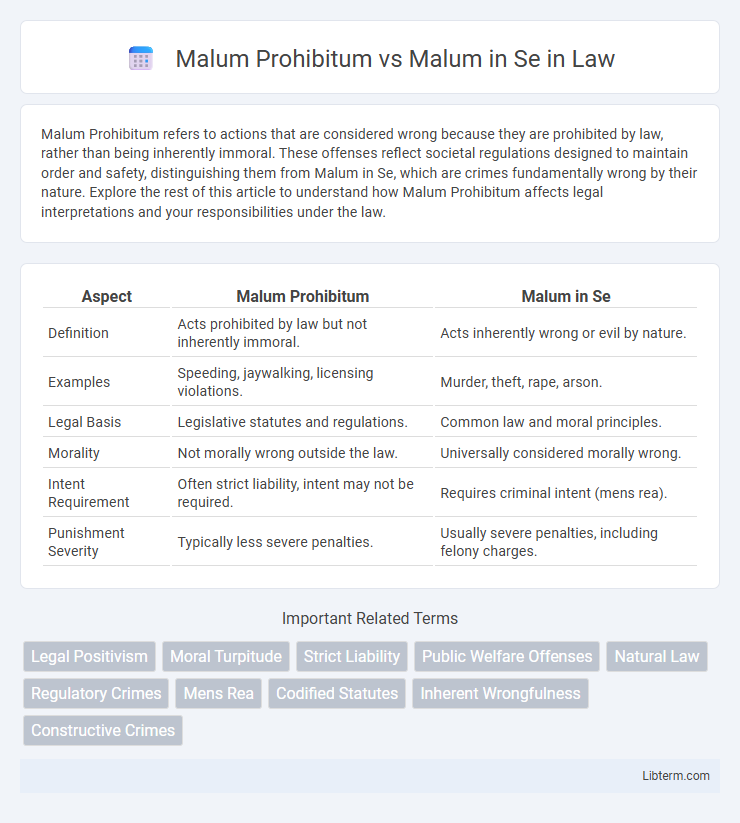Malum Prohibitum refers to actions that are considered wrong because they are prohibited by law, rather than being inherently immoral. These offenses reflect societal regulations designed to maintain order and safety, distinguishing them from Malum in Se, which are crimes fundamentally wrong by their nature. Explore the rest of this article to understand how Malum Prohibitum affects legal interpretations and your responsibilities under the law.
Table of Comparison
| Aspect | Malum Prohibitum | Malum in Se |
|---|---|---|
| Definition | Acts prohibited by law but not inherently immoral. | Acts inherently wrong or evil by nature. |
| Examples | Speeding, jaywalking, licensing violations. | Murder, theft, rape, arson. |
| Legal Basis | Legislative statutes and regulations. | Common law and moral principles. |
| Morality | Not morally wrong outside the law. | Universally considered morally wrong. |
| Intent Requirement | Often strict liability, intent may not be required. | Requires criminal intent (mens rea). |
| Punishment Severity | Typically less severe penalties. | Usually severe penalties, including felony charges. |
Introduction to Malum Prohibitum and Malum in Se
Malum prohibitum refers to acts that are considered wrong because they are prohibited by law, such as jaywalking or licensing violations, emphasizing statutory regulations rather than inherent moral wrongness. In contrast, malum in se describes actions that are inherently evil or morally wrong, like murder or theft, recognized universally across cultures and legal systems. Understanding the distinction between these legal concepts helps clarify why some offenses are punishable due to societal norms, while others are condemned based on fundamental ethical principles.
Defining Malum Prohibitum
Malum Prohibitum refers to actions that are considered wrong because they are prohibited by law, rather than inherently immoral or evil. These offenses, such as regulatory violations or statutory prohibitions, depend on legal statutes for their illegality and do not involve moral wrongdoing by nature. Understanding Malum Prohibitum is essential for distinguishing legal faults based on societal rules from offenses that are intrinsically wrong, categorized as Malum in Se.
Defining Malum in Se
Malum in Se refers to actions that are inherently immoral or evil by their very nature, such as murder, rape, or theft, which violate fundamental ethical principles recognized universally. These acts are considered intrinsically wrong regardless of legal statutes, reflecting deep-seated moral transgressions rooted in natural law and societal consensus. Understanding Malum in Se is crucial for differentiating crimes based on their inherent morality rather than regulatory violations, which are classified as Malum Prohibitum.
Key Differences Between Malum Prohibitum and Malum in Se
Malum Prohibitum offenses are wrong because they are prohibited by law, such as jaywalking or licensing violations, whereas Malum in Se offenses are inherently evil or morally wrong, like murder or theft. The key difference lies in the nature of the act: Malum in Se crimes are universally condemned due to their intrinsic harm, while Malum Prohibitum crimes depend on specific legal statutes and vary across jurisdictions. Understanding this distinction is crucial for legal interpretation, enforcement, and the assignment of culpability in criminal justice systems.
Legal Origins and Historical Background
Malum in se refers to actions inherently wrong or evil by their very nature, such as murder or theft, with legal origins rooted in natural law theories dating back to ancient civilizations like Rome and Greece. Malum prohibitum encompasses acts criminalized by statute but not inherently immoral, such as jaywalking or licensing violations, reflecting evolving societal standards codified through legislative processes. Historically, common law systems emphasized malum in se offenses, while modern statutory law increasingly addresses malum prohibitum to regulate complex social behavior.
Examples of Malum Prohibitum Offenses
Malum Prohibitum offenses are acts that are prohibited by law but are not inherently evil, such as jaywalking, parking violations, and fishing without a license. These offenses contrast with Malum in Se crimes, which include inherently wrongful acts like murder, theft, and arson. Understanding the distinction helps clarify that Malum Prohibitum laws regulate conduct for public order rather than address moral wrongdoing.
Examples of Malum in Se Offenses
Malum in se offenses are inherently wrong acts recognized universally, such as murder, rape, and theft, which violate fundamental moral principles. These crimes are punishable because they are intrinsically evil, regardless of any laws. Examples like arson and assault also fall under malum in se, emphasizing their prohibition due to their inherently harmful nature.
Legal and Moral Implications
Malum Prohibitum refers to actions deemed illegal by statute but not inherently immoral, such as jaywalking, emphasizing societal regulation rather than moral wrongdoing. Malum in Se offenses, including murder and theft, violate fundamental moral principles and are universally condemned across cultures and legal systems. The distinction influences legal consequences and moral judgments, with Malum in Se crimes often triggering more severe penalties and ethical censure due to their intrinsic harm.
Impact on Criminal Law and Justice System
Malum Prohibitum offenses, defined as acts prohibited by statute but not inherently evil, shape criminal law by emphasizing regulatory compliance and statutory interpretation, often leading to varied enforcement based on jurisdictional policy priorities. Malum in Se crimes, inherently immoral and universally condemned, drive the justice system towards stringent punishment and moral culpability, reinforcing fundamental societal values and legal principles. The distinction influences legal defenses, sentencing severity, and public perception, affecting prosecutorial discretion and judicial outcomes in criminal proceedings.
Contemporary Relevance and Debates
Malum prohibitum refers to acts prohibited by law but not inherently wrong, such as regulatory offenses, while malum in se involves actions universally recognized as morally wrong, like murder and theft. Contemporary debates focus on the appropriate scope of criminal law, questioning if punishing malum prohibitum offenses unduly criminalizes conduct without clear moral culpability, impacting criminal justice reform and public perception. The distinction remains crucial in policy discussions on overcriminalization, law enforcement priorities, and the balance between societal order and individual freedoms.
Malum Prohibitum Infographic

 libterm.com
libterm.com